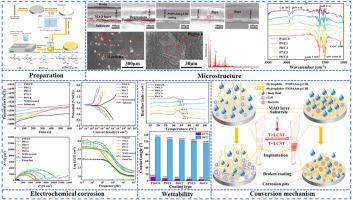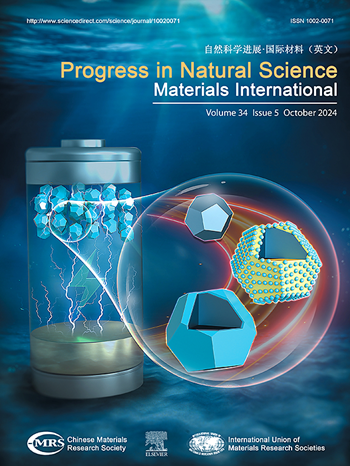A novel hydrophilic-to-hydrophobic convertible coating on biodegradable Mg-4Zn-1Mn alloy: Preparation, microstructure and corrosion behaviour
IF 7.1
2区 材料科学
Q2 MATERIALS SCIENCE, MULTIDISCIPLINARY
Progress in Natural Science: Materials International
Pub Date : 2025-08-01
DOI:10.1016/j.pnsc.2025.04.006
引用次数: 0
Abstract
A series of hydrophilic-to-hydrophobic convertible coatings, consisting of copolymers made from poly (N-isopropyl acrylamide) (PNIPAAm) and chitosan (CHI) with various CHI/PNIPAAm ratios, were prepared on Mg-4Zn-1Mn alloy surface pretreated by micro-arc oxidation (MAO) to improve its corrosion behaviour. Microstructural analysis demonstrated successful deposition of the PNIPAAm-g-CHI coatings and their thickness increased with increasing CHI/PNIPAAm ratio. The bonding strength of the coatings became worse as the CHI/PNIPAAm ratio increased and the strongest bonding was obtained at CHI/PNIPAAm ratios of 0:10 and 1:9. The electrochemical corrosion tests indicated that the corrosion behaviour of the coatings deteriorated as the CHI/PNIPAAm ratio increased. The coating with a CHI/PNIPAAm ratio of 0:10 exhibited the optimal corrosion resistance, demonstrating an impedance of 9455.2 Ω cm2 and a corrosion current density of 0.179 μA/cm2, which was about respectively 2 times higher and 10 times lower than those of the MAO-treated sample. The surface wettability measurements revealed that the lower critical solution temperature (LCST) progressively became higher when the CHI/PNIPAAm ratio increased, resulting in a continuous decrease in the water contact angle. The coatings presented hydrophobic properties above the LCST, whereas they displayed hydrophilic below the LCST.

可生物降解Mg-4Zn-1Mn合金上一种新型亲疏水转换涂层:制备、微观结构和腐蚀行为
在经微弧氧化(MAO)预处理的Mg-4Zn-1Mn合金表面制备了一系列由不同CHI/PNIPAAm比例的聚n-异丙基丙烯酰胺(PNIPAAm)和壳聚糖(CHI)共聚物组成的亲疏水可转换涂层,以改善其腐蚀性能。显微结构分析表明PNIPAAm-g-CHI涂层沉积成功,涂层厚度随CHI/PNIPAAm比的增加而增加。随着CHI/PNIPAAm比例的增加,涂层的结合强度变差,在CHI/PNIPAAm比例为0:10和1:9时,涂层的结合强度最强。电化学腐蚀试验表明,随着CHI/PNIPAAm比例的增加,涂层的腐蚀性能逐渐恶化。当CHI/PNIPAAm比为0:10时,涂层的耐蚀性能最佳,阻抗为9455.2 Ω cm2,腐蚀电流密度为0.179 μA/cm2,分别是mao处理样品的2倍和10倍左右。表面润湿性测量表明,随着CHI/PNIPAAm比例的增加,低临界溶液温度(LCST)逐渐升高,导致水接触角持续降低。涂层在LCST以上表现为疏水性,而在LCST以下表现为亲水性。
本文章由计算机程序翻译,如有差异,请以英文原文为准。
求助全文
约1分钟内获得全文
求助全文
来源期刊
CiteScore
8.60
自引率
2.10%
发文量
2812
审稿时长
49 days
期刊介绍:
Progress in Natural Science: Materials International provides scientists and engineers throughout the world with a central vehicle for the exchange and dissemination of basic theoretical studies and applied research of advanced materials. The emphasis is placed on original research, both analytical and experimental, which is of permanent interest to engineers and scientists, covering all aspects of new materials and technologies, such as, energy and environmental materials; advanced structural materials; advanced transportation materials, functional and electronic materials; nano-scale and amorphous materials; health and biological materials; materials modeling and simulation; materials characterization; and so on. The latest research achievements and innovative papers in basic theoretical studies and applied research of material science will be carefully selected and promptly reported. Thus, the aim of this Journal is to serve the global materials science and technology community with the latest research findings.
As a service to readers, an international bibliography of recent publications in advanced materials is published bimonthly.

 求助内容:
求助内容: 应助结果提醒方式:
应助结果提醒方式:


